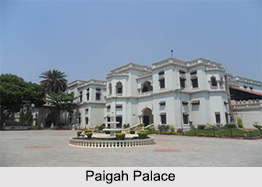 Paigah Palace is a beautiful palace built by Sir Vicar-ul-Umra, one of the Paigah noblemen in Hyderabad. Hyderabad is now the capital city of Telangana. It is an example of architectural splendour; where one can find the Neo Classical art and architecture of the late 16th Century. Paigah Palace was built by Sir Vicar-ul-Umra, a Paigah nobleman.
Paigah Palace is a beautiful palace built by Sir Vicar-ul-Umra, one of the Paigah noblemen in Hyderabad. Hyderabad is now the capital city of Telangana. It is an example of architectural splendour; where one can find the Neo Classical art and architecture of the late 16th Century. Paigah Palace was built by Sir Vicar-ul-Umra, a Paigah nobleman.
Origin of Paigah Palace
Paigah Palace was originally built by Nawab Vikarul - Umra, Iqbaluddoula. This was later acquired by the Nizam VI. Vikarul Umra also built the Paigah Palace in Begumpet district. It is now presently placed as the office of USA Consulate and having previously hosted the office of Hyderabad Urban Development Authority.
History of Paigah Palace
Paigah Palace was built after he gifted the famous Falaknuma Palace to the sixth Nizam of Hyderabad state, Mahbub Ali Khan, Asaf Jah VI. Soon after this, the Paigah family ranked next to the ruling family of Nizams in the hierarchy of nobles of Hyderabad.
Abul Fateh Khan Tegh Jung Bahadur, progenitor of Paigah family migrated to Hyderabad in the late 1740s. Paigah family was also the foremost palace builders of Hyderabad.
Architecture of Paigah Palace
Dating back to the 1880s, Paigah Palace is a large two storied neo-classical building with a portico, semicircular arches, unfluted Corinthian columns, projected and pediment windows and deep arcaded verandahs on all four sides. Near Paigah Palace lies the Deorhi of Nazir Nawaz Jung, who was the grand son of Vikarul Umra. Paigah Palace however was built in the 1880s.
It is a beautiful and large two storied palace in European style. It has wide verandas facing outwards as well as inwards overlooking a courtyard. The complex of Paigah Palace is partly converted into a club. The rest of the area is used as a residence. And other part of the palace hosts a number of cultural events and the marriage ceremonies.
Palaces of other nobles of the Paigah family includes Asman Jah (Bashiruddoula) and Khursid Jah which are in poor state of preservation in the old palace of Paigah. The most important palace of Bashiruddoula, the Bashirbagh Palace, situated north of the old city has been demolished. Asman Garh Palace, a smaller but interesting European-style palace on a hilltop in Dilsukhnagar is still surviving with its beauty and glamour.



















